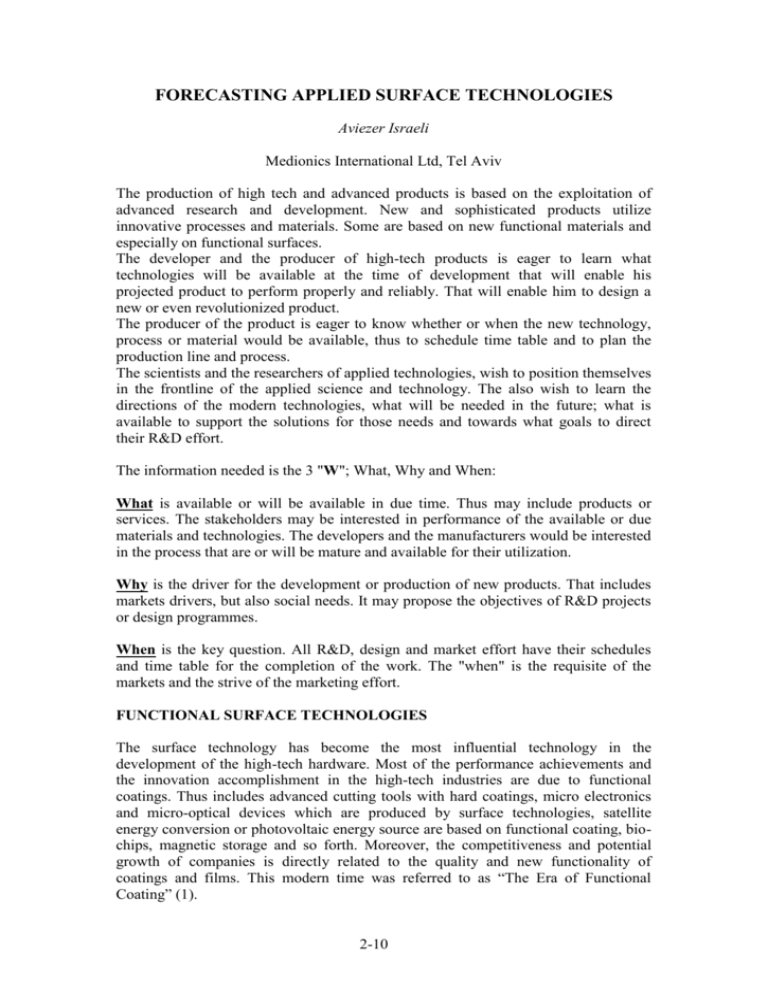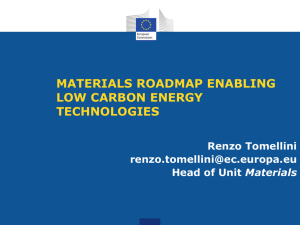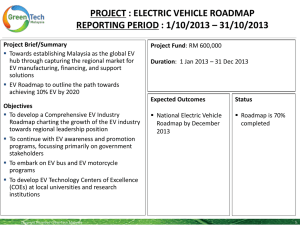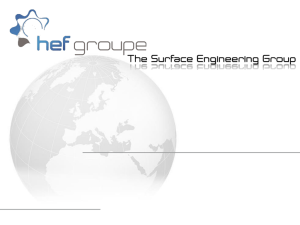FORECASTING APPLIED SURFACE TECHNOLOGIES
advertisement

FORECASTING APPLIED SURFACE TECHNOLOGIES Aviezer Israeli Medionics International Ltd, Tel Aviv The production of high tech and advanced products is based on the exploitation of advanced research and development. New and sophisticated products utilize innovative processes and materials. Some are based on new functional materials and especially on functional surfaces. The developer and the producer of high-tech products is eager to learn what technologies will be available at the time of development that will enable his projected product to perform properly and reliably. That will enable him to design a new or even revolutionized product. The producer of the product is eager to know whether or when the new technology, process or material would be available, thus to schedule time table and to plan the production line and process. The scientists and the researchers of applied technologies, wish to position themselves in the frontline of the applied science and technology. The also wish to learn the directions of the modern technologies, what will be needed in the future; what is available to support the solutions for those needs and towards what goals to direct their R&D effort. The information needed is the 3 "W"; What, Why and When: What is available or will be available in due time. Thus may include products or services. The stakeholders may be interested in performance of the available or due materials and technologies. The developers and the manufacturers would be interested in the process that are or will be mature and available for their utilization. Why is the driver for the development or production of new products. That includes markets drivers, but also social needs. It may propose the objectives of R&D projects or design programmes. When is the key question. All R&D, design and market effort have their schedules and time table for the completion of the work. The "when" is the requisite of the markets and the strive of the marketing effort. FUNCTIONAL SURFACE TECHNOLOGIES The surface technology has become the most influential technology in the development of the high-tech hardware. Most of the performance achievements and the innovation accomplishment in the high-tech industries are due to functional coatings. Thus includes advanced cutting tools with hard coatings, micro electronics and micro-optical devices which are produced by surface technologies, satellite energy conversion or photovoltaic energy source are based on functional coating, biochips, magnetic storage and so forth. Moreover, the competitiveness and potential growth of companies is directly related to the quality and new functionality of coatings and films. This modern time was referred to as “The Era of Functional Coating” (1). 2-10 Functional coatings and films play strategic importance in many industrial sectors. Herein some such areas and sectors: Magnetic storage of high area recording density is subject to competitive technologies. Such are electroplating, vacuum deposition and creation of nanostructured magnetic films. Energy conversion: Solar systems benefit from abortive and reflective functional coatings. Photovoltaic cells are based on functional surface technologies. Multilayer coating plays a huge role in optics and other products. Certain laser mirrors are made of dielectric multilayer. Mechanical products, such as tooth drill-teeth have composite coating of diamonds/nickel. Future cutting tools will have the advantage of hard multilayer coatings such as TiN/Ti(C,N), or hybrid intermetallic NiTi plasma spraying and laser remelting surface finishing (2). Also micro-laminated hybrid coatings will offer an opportunity to establish unique and controllable microstructural characteristics. Artificial heart valves enjoy hybrid ion implantation and plasma coating of TiO/TiN for blood compatibility and erosion resistance. Similar hard and organ-compatible coating is used for implants. Microelectronics benefit from plating technologies that are considered as state-of-theart in product development, such as: flip-chip wafer bumping, electroless plating of via holes for IC interconnects, passive alignment of devices, plating for miniaturised components - the application of ultrasonic irradiation will improve deposition characteristics and uniformity on the nanometer scale The miniaturization of electronic to nano-size components and interconnects, requires further advanced surface technologies In the area of plastic electronics it is believed that reel-to-reel processes to manufacture organic devices on low cost large area substrates will make disposable electronics possible. Plastic electronics will be used for flexible displays, price tags and intelligent packages for food. Corrosion, tribological or tribo-corrosion surface finishing may take advantage of new and knowledge based surface materials. Such as micro- and nano-structuring of surfaces and micro-/nano-wear or –anti corrosion characterised and developed surface modifications. In the frame of bionic systems research is aimed at neurons-on-a-chip (neurotransmitter), where bi-directional signals through optimised molecular/ semiconductor interfaces allow bio-directional communication between neurons and electronics The introduction of nano and molecular size surface and film technologies are a breakthrough in industrial systems and products, particularly because they have the ability to create new scales of property enhancement within conventional coating materials.. Bio-technology; Specifically for Bio-sensor-System-in-a-Package (SIP) the medical, agro-industrial and environmental applications will take the lead. Affinity Bio-sensor systems and Bionic systems use Molecular Nano-technology to create self-assembling molecules and mono-layers (SAM) to immobilise receptor biomolecules on a chip through covalent binding with silanes or thiols. The know-how in the field of SAM will form the basis for further developments in the field of molecular electronics e.g. using stamping on semiconductors. 2-11 The critical role of the functional coatings and films in modern technology, and the strategic part it plays in advanced product, requires a reliable and constructive forecast and roadmap. THE ROADMAP The proposed roadmap style needs to answer the above requirements. Current roadmaps are drawn in such a way that demonstrates activities or technologies in a time frame. Such is the Gantt chart. The purposed roadmap structure is beneficial to R&D teams and to cutting-edge industries. Scientific research and technology development is a sequential processes. Those are built step by step. Each new process is based on former discoveries and development. It contributes knowledge and supports the acquisition of know-how. A future product will be based on already available knowledge but also on the development of new materials or processes that would enable that product. Therefore, a proper roadmap should demonstrate not only future products versus time but also the knowledge and the sequential steps that will lead to that product. Laying brick on brick in a sequential way (3) The developed roadmap for functional films and coatings is based on the following. The roadmap assumes that the sequence of innovations towards a product has the following steps: Resources The resources are the basis for the development or production of a new technology or product. The resources are the knowledge that is available or has to be acquired either by learning or by R&D activities. The resources are also the technology that is required for the R&D or for the structuring of the needed product. The terminology of resources covers Technology / Research / Knowledge. Delivery The deliveries are the technologies or items that are required in order to achieve the goals of the society. If someone required a new device, the deliveries would be processes, new materials and methods that should support the development or the production of the new device. The terms that describe deliveries are Products / Services / Performance/ Processes. Purpose The purpose is the target of the former step. The use of the resources and the application of the deliveries are focused towards the purpose of the activity. The purpose is derived from the following: Market / Drivers. The above steps are illustrated in a bottom up order. Thus to say, the deliveries are based on resources, and the target (purpose) is derived from the deliveries. However, the supplier of the end product may study the roadmap top to bottom. Knowing the market requirement of market drivers, he asks himself, what will be the step to achieve those and what is the time span to reach his objectives. Since the steps towards end product are sequential, those are described also in a time frame. The roadmap can be a working paper, where each step and action is designed by dates or time. This is the case of a roadmap in projects or workplan. 2-12 The proposed roadmap is illustrative, since it describes the development of technology in general terms. The time span is divided into Past, Present, Future and Vision. The enclosed roadmap is a demonstration of the method proposed in this work (Fig. 1). It illustrates functional films and functional coatings for microelectronics. It shows the recent history of microelectronics' surface technologies, the current status, near and far (vision) future of the technologies. It shows the relations between the surface technologies that contribute to the advancement of microelectronics, and the outcome of products or end user benefits. Fig. 1. Roadmap: Functional Surfaces and Films for Microelectronics. SUMMARY This work presents a new method to demonstrate forecasting future technologies and products. The method utilizes an advanced roadmap presentation for modern technologies. The roadmap is based on the relations between contributing technologies and end products versus time. The paper discusses a way to present forecasting functional surface technologies by using advanced roadmap. It demonstrates the method on functional surfaces and films for microelectronics, and the sequential innovations required to achieve forecasted microelectronics objectives (see Fig. 1). The proposed roadmap is applicable for R&D planning. It should serve R&D authorities, industries, R&D policy makers and research centres. It is an efficient tool for all those dealing with innovation and hi-tech market advancement. ACKNOWLEDGEMENT This work was supported by the European Commission, R&D Framework Programme. REFERENCES 1. A. Israeli, The Era of Functional Coating. 1st Keynote paper at the 12th World Congress on Metal Finishing, Paris, France, Oct. 1988. 2. A. Israeli, Directions in Functional Coatings for Mechanical applications, 8th Israel Conference on Corrosion, Haifa, May 21, 2007. 3. A. Israeli, Roadmap for Functional Coating and Surface Modification, The American Electroplaters and Surface Finishing conference, USA, June 2004. 2-13







